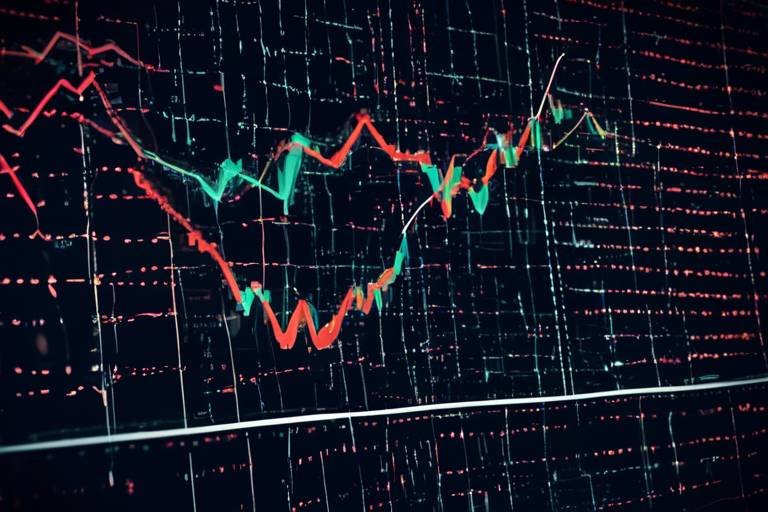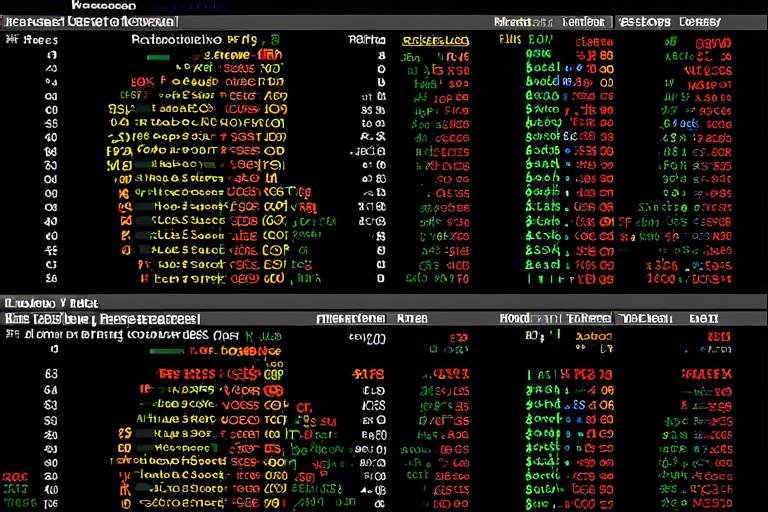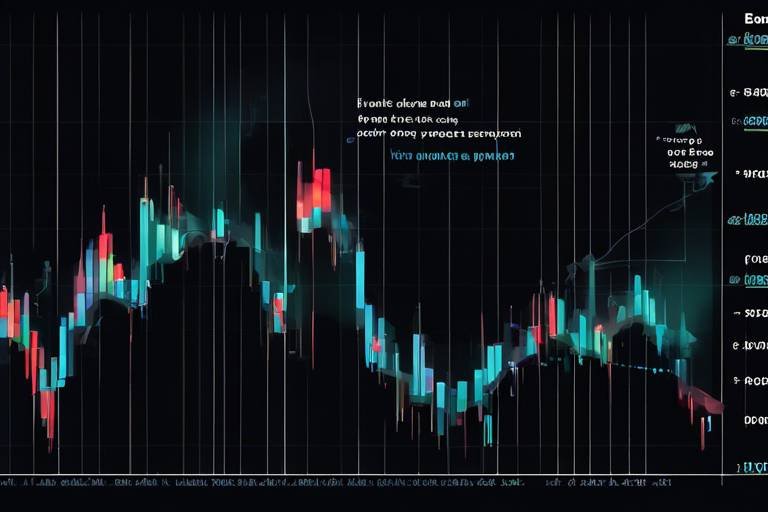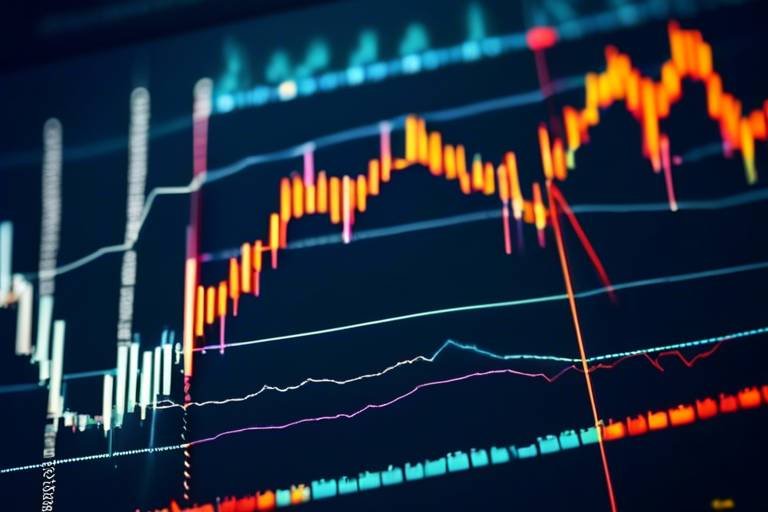How to Use Price Patterns for Predicting Future Movements
In the dynamic world of financial markets, price patterns serve as invaluable tools for traders seeking to navigate the complexities of price movements. These patterns, formed by historical price data, can provide critical insights into potential future trends. By learning to recognize and interpret these formations, traders can enhance their strategies and make more informed decisions. Understanding price patterns is akin to having a roadmap in a chaotic environment; it can guide you through uncertainty and help you capitalize on opportunities that arise.
Price patterns are not just random shapes on a chart; they represent the collective psychology of market participants. When traders buy or sell, they create these patterns based on their expectations and reactions to market conditions. Consequently, identifying these formations can help traders anticipate whether a trend will continue or reverse, allowing them to position themselves advantageously. Imagine standing at a crossroads, where each path represents a different market direction. By recognizing the signs on each road, you can choose the best route to take, minimizing risks and maximizing potential rewards.
As we dive deeper into the world of price patterns, it’s essential to understand that not all patterns are created equal. Some indicate potential reversals, while others suggest that a trend will continue. By categorizing these patterns effectively, traders can develop a more profound understanding of market behavior. This knowledge empowers them to make decisions that align with the prevailing momentum, ultimately enhancing their trading performance. In the following sections, we will explore various types of price patterns, their characteristics, and how to incorporate them into effective trading strategies.
Price patterns are formations created by historical price movements on charts. Recognizing these patterns helps traders identify potential reversals or continuations in market trends, providing critical insights for making informed trading decisions. Each pattern tells a story about the market's past behavior, and understanding these narratives can give traders an edge. It’s like reading a book where every chapter reveals essential clues about what might happen next.
There are various price patterns, including head and shoulders, triangles, and flags. Each type has unique characteristics that can indicate potential market behavior, helping traders anticipate future price movements effectively. Recognizing these patterns is crucial for developing a robust trading strategy. Just like a skilled detective, a trader must piece together clues to forecast what might unfold in the market.
Reversal patterns signify potential changes in market direction. Identifying these patterns can alert traders to possible trend shifts, allowing them to adjust their strategies accordingly for optimal results. Think of these patterns as warning signs on a highway, signaling that a change in direction is imminent. By paying attention to these signals, traders can avoid costly mistakes and position themselves for success.
The head and shoulders pattern indicates a reversal in trend direction. Recognizing this formation can help traders make timely decisions to capitalize on potential market shifts. This pattern forms when prices create three peaks: a higher peak (the head) between two lower peaks (the shoulders). When this pattern appears, it’s like a red flag waving, alerting traders that a trend reversal may be on the horizon.
Double tops and bottoms are classic reversal patterns that signal potential market reversals. Understanding these formations is crucial for traders looking to enter or exit positions strategically. A double top occurs when the price reaches a high point twice before reversing, while a double bottom is the opposite, indicating a potential upward shift after two low points. Recognizing these patterns can be the difference between a profitable trade and a missed opportunity.
Continuation patterns suggest that the current trend will persist after a brief consolidation. Recognizing these patterns allows traders to stay aligned with prevailing market momentum and maximize profits. It’s like a runner taking a short breather before sprinting again; the race isn’t over yet, and the trend is likely to continue. Patterns such as flags and pennants are excellent indicators of this behavior, providing traders with the confidence to ride the wave of momentum.
Incorporating price patterns into trading strategies enhances decision-making. By aligning trades with identified patterns, traders can improve their risk-reward ratios and overall trading performance. This alignment is crucial because it allows traders to make informed choices rather than relying on gut feelings. It’s like having a compass in the wilderness; it directs you toward your desired destination while avoiding potential pitfalls.
Price patterns assist traders in determining optimal entry and exit points. By analyzing patterns, traders can strategically position themselves to capitalize on potential price movements and minimize losses. The key is to enter the market when the pattern confirms a potential move, ensuring that traders are not caught off guard by sudden fluctuations. Think of it as timing your jump on a trampoline; you want to bounce at just the right moment to achieve maximum height.
Effective risk management is vital when trading based on price patterns. Implementing stop-loss orders and position sizing helps safeguard against unforeseen market fluctuations while maximizing potential gains. Without a solid risk management plan, even the best trading strategy can lead to significant losses. It’s like wearing a seatbelt in a car; it might not prevent an accident, but it can protect you from severe consequences.
- What are price patterns? Price patterns are formations created by historical price movements on charts that help traders predict future price movements.
- Why are price patterns important in trading? They provide critical insights into potential market reversals or continuations, allowing traders to make informed decisions.
- How can I identify price patterns? By analyzing historical price charts and recognizing specific formations such as head and shoulders, double tops/bottoms, and flags.
- Can price patterns guarantee market movements? No, while they can indicate potential movements, they are not guarantees; market conditions can change rapidly.

Understanding Price Patterns
Price patterns are fascinating formations that emerge from the historical movements of prices on financial charts. These patterns serve as a visual representation of market behavior, allowing traders to glean vital insights into potential future price movements. Think of price patterns as the fingerprints of market sentiment; they tell a story about what has happened in the past and hint at what might come next. By studying these patterns, traders can make informed decisions, much like a detective piecing together clues to solve a mystery.
Recognizing price patterns is crucial for several reasons. Firstly, they help in identifying potential reversals or continuations in market trends. This knowledge can be a game-changer, enabling traders to enter or exit positions at the right time. Imagine standing at a crossroads; understanding price patterns is like having a reliable map that guides you toward the best path. Moreover, these patterns can indicate the strength of a trend, giving traders a clearer picture of whether to ride the wave or prepare for a pullback.
Price patterns can be categorized into two main types: reversal patterns and continuation patterns. Each type carries its own significance and implications for traders. Reversal patterns signal a potential change in direction, while continuation patterns suggest that the current trend is likely to persist. This distinction is essential for traders as it shapes their strategies and influences their risk management techniques. For instance, if a trader spots a reversal pattern like a head and shoulders formation, they might decide to exit a long position or even take a short position, anticipating a downward shift.
To further illustrate the importance of understanding price patterns, consider the following table that summarizes the key characteristics of reversal and continuation patterns:
| Type of Pattern | Characteristics | Implication for Traders |
|---|---|---|
| Reversal Patterns | Indicate potential changes in market direction | Opportunity to enter or exit trades based on trend shifts |
| Continuation Patterns | Suggest that the current trend will continue | Opportunity to ride the trend and maximize profits |
In conclusion, understanding price patterns is not just a technical skill; it's an art that combines analytical thinking with a keen sense of market psychology. By mastering this art, traders can enhance their decision-making processes and potentially increase their profitability. So the next time you look at a price chart, remember that each pattern is a clue waiting to be uncovered, guiding you through the complexities of the financial markets.

Types of Price Patterns
When it comes to trading, understanding the is crucial for making informed decisions. Price patterns are like the fingerprints of market behavior; they reveal the history of price movements and hint at what might come next. By recognizing these patterns, traders can gain insights into potential future price movements, helping them to either ride the wave of the current trend or prepare for a reversal. Let's dive into some of the most common price patterns that traders encounter in their journey.
Price patterns generally fall into two categories: reversal patterns and continuation patterns. Each type serves a different purpose and can provide valuable signals for traders. Reversal patterns indicate that a trend may be about to change direction, while continuation patterns suggest that the current trend is likely to persist after a brief pause. Understanding these distinctions can make a world of difference in your trading strategy.
Within these two categories, we have several specific patterns that traders should familiarize themselves with. Here’s a brief overview of some of the most significant patterns:
| Pattern Type | Pattern Name | Description |
|---|---|---|
| Reversal | Head and Shoulders | A formation that indicates a potential trend reversal from bullish to bearish. |
| Reversal | Double Tops and Bottoms | Classic formations signaling potential reversals in market direction. |
| Continuation | Triangles | Patterns that suggest the market is consolidating before continuing in the same direction. |
| Continuation | Flags and Pennants | Short-term patterns that indicate a brief consolidation before the trend resumes. |
Recognizing these patterns can be the key to unlocking your trading potential. For instance, the head and shoulders pattern is particularly notable because it can signal a major trend reversal. Imagine you’re surfing; if you see a big wave forming behind you, it’s time to paddle hard and get ready for the ride. Similarly, identifying a head and shoulders pattern can prepare you for a significant market shift.
On the other hand, continuation patterns like triangles and flags can be likened to a runner taking a quick breather before dashing off again. These patterns suggest that the current trend is likely to continue after a short period of consolidation, allowing traders to stay in the game and maximize their profits. By understanding the nuances of these patterns, traders can position themselves advantageously and make more strategic decisions.
In summary, familiarizing yourself with the various types of price patterns is essential for any trader looking to enhance their market strategies. Whether you're preparing for a trend reversal or riding the current wave, recognizing these patterns can provide you with a significant edge in the fast-paced world of trading.

Reversal Patterns
Reversal patterns are like the alarm bells of the trading world, signaling potential changes in market direction that traders simply can't afford to ignore. Imagine you're cruising down a highway, and suddenly, you see a sign that warns of a sharp turn ahead. That's what reversal patterns do for traders—they provide critical insights that can help avoid costly mistakes. By recognizing these patterns, traders can adjust their strategies to either capitalize on impending shifts or safeguard their investments from unexpected downturns.
One of the most recognized reversal patterns is the head and shoulders formation. This pattern typically appears after a bullish trend and indicates a potential shift to a bearish trend. Picture a person with a head and two shoulders; the middle peak (the head) is higher than the two outer peaks (the shoulders). When traders spot this pattern, it often signals that the buying pressure is weakening, and a reversal may be on the horizon. This is a golden opportunity for traders to enter short positions or exit long ones, maximizing their profits before the market shifts.
Another classic reversal pattern is the double top and double bottom. These formations are like the market's way of saying, "Hold on, something's about to change!" A double top occurs after an upward trend, where the price reaches a peak twice before declining, indicating that the buyers are losing steam. Conversely, a double bottom appears after a downward trend, where the price hits a low twice before rising, suggesting that sellers are losing control. Understanding these patterns is crucial for traders who want to make informed decisions about when to enter or exit positions.
To illustrate how these reversal patterns can impact trading strategies, consider the following table:
| Pattern Type | Market Direction | Trading Action |
|---|---|---|
| Head and Shoulders | Bearish Reversal | Sell/Short Position |
| Double Top | Bearish Reversal | Sell/Short Position |
| Double Bottom | Bullish Reversal | Buy/Long Position |
By keeping an eye on these patterns, traders can effectively position themselves to take advantage of market reversals. But it's not just about spotting these formations; it's also about timing. The key is to wait for confirmation before making any trades. For instance, after identifying a head and shoulders pattern, traders should look for a break below the neckline, which serves as a confirmation signal that the bearish trend is likely to follow. This careful approach ensures that traders are not just reacting to patterns but are making informed decisions based on market behavior.
In conclusion, mastering reversal patterns is essential for any trader looking to enhance their trading strategies. By recognizing these formations and understanding their implications, traders can navigate the markets more effectively, making decisions that align with potential market shifts. So, the next time you're analyzing a price chart, remember: those patterns could hold the key to your trading success!
- What are reversal patterns? Reversal patterns indicate a potential change in the direction of a market trend, helping traders make informed decisions.
- How can I identify a head and shoulders pattern? Look for three peaks: the first and third should be lower than the second peak, which is the "head."
- What should I do after identifying a reversal pattern? Wait for confirmation, such as a break in price levels, before entering a trade to ensure you're making informed decisions.

Head and Shoulders
The pattern is one of the most recognizable and significant formations in technical analysis. It often indicates a reversal in the prevailing trend, making it a vital tool for traders looking to capitalize on potential market shifts. Imagine you're climbing a mountain, and as you reach the peak, you notice a steep decline ahead. That peak represents the "head," while the two lower peaks on either side symbolize the "shoulders." This visual representation helps traders identify when a bullish trend may be losing steam and a bearish trend could be on the horizon.
Understanding the components of the head and shoulders pattern is crucial. The pattern consists of three main parts:
- Left Shoulder: This is formed after a price increase, followed by a decline, creating a peak.
- Head: The highest peak, which occurs after the left shoulder, followed by another decline.
- Right Shoulder: This is similar to the left shoulder, formed after the head, and indicates a potential trend reversal.
When the price breaks below the neckline, which is drawn by connecting the lows of the two shoulders, it serves as a confirmation of the reversal. This is the moment when traders often make their move. But why stop there? The head and shoulders pattern not only signals a potential change in direction but also provides a target for traders. By measuring the distance from the head to the neckline and projecting that distance downward from the neckline break, traders can set realistic profit targets.
One of the best aspects of the head and shoulders pattern is its versatility. It can occur in various time frames, whether you're day trading or holding positions for the long term. However, just like any other trading strategy, it's essential to combine this pattern with other indicators and tools to enhance your decision-making process. For instance, using volume analysis can provide additional confirmation of the pattern's validity. If the volume increases significantly during the formation of the right shoulder and then spikes when the neckline is broken, it adds credibility to the signal.
In conclusion, the head and shoulders pattern is a powerful tool in a trader's arsenal. By recognizing this formation early and understanding its implications, traders can make informed decisions that align with market movements. Just as a seasoned hiker knows when to turn back after reaching a peak, savvy traders can use the head and shoulders pattern to navigate the volatile landscape of financial markets.

Double Tops and Bottoms
The are classic price patterns that traders often rely on to predict potential market reversals. These formations can serve as powerful indicators of market sentiment, signaling when a trend may be losing momentum. A double top occurs after an upward trend, where the price reaches a peak, retreats, and then rises again to the same level before reversing downward. Conversely, a double bottom forms after a downward trend, where the price hits a low, rebounds, and then falls again to the same level before reversing upward. Recognizing these patterns is crucial for traders who want to enter or exit positions strategically.
To illustrate, let’s break down the characteristics of these patterns:
| Pattern Type | Formation | Trading Implication |
|---|---|---|
| Double Top | Two peaks at the same price level | Potential trend reversal downwards |
| Double Bottom | Two troughs at the same price level | Potential trend reversal upwards |
Now, why should traders pay attention to these patterns? Well, they can act like a warning signal for potential changes in market direction. When a double top forms, it suggests that buyers are losing their strength and sellers are starting to take control. This shift can lead to a significant price drop, allowing savvy traders to profit from the impending downturn. On the flip side, a double bottom indicates that sellers are losing their grip, and buyers are beginning to step in, which can create opportunities for upward movement.
Moreover, the reliability of these patterns increases when they are confirmed by other technical indicators, such as volume or moving averages. For instance, if a double top is accompanied by a decrease in volume, it reinforces the likelihood of a trend reversal. Similarly, if a double bottom forms and is followed by a bullish crossover in moving averages, it can provide additional confidence for traders looking to enter long positions.
In summary, understanding double tops and bottoms is essential for traders aiming to enhance their market strategies. By recognizing these patterns and their implications, traders can make more informed decisions, potentially leading to improved trading outcomes. Always remember, though, that while these patterns can offer valuable insights, they should be used in conjunction with other tools and analysis methods to maximize effectiveness.
- What is the significance of double tops and bottoms in trading?
Double tops and bottoms indicate potential reversals in market trends, helping traders identify strategic entry and exit points. - How can I confirm a double top or bottom?
Confirmation can be achieved through additional technical indicators such as volume analysis or moving averages. - Are double tops and bottoms reliable?
While they can be reliable indicators, it's important to use them in conjunction with other analysis techniques to improve accuracy.

Continuation Patterns
When it comes to trading, understanding is like having a treasure map that leads you to potential profits. These patterns are fascinating because they indicate that the current trend is likely to continue after a brief pause or consolidation. Imagine you’re on a road trip; just because you hit a rest stop doesn’t mean you’re changing your destination. Instead, you’re just refueling before hitting the road again, and that’s precisely what these patterns signify in the financial markets.
One of the most common types of continuation patterns is the flag pattern. Picture a flag waving in the wind; it represents a brief period of consolidation before the price resumes its original direction. Flags usually form after a strong price movement, and their shape resembles a parallelogram, tilted against the prevailing trend. Traders often look for a breakout from the flag pattern to confirm that the trend will continue. The key here is to watch for volume spikes during the breakout, as this can provide additional confirmation of the trend's strength.
Another notable continuation pattern is the pennant. This pattern resembles a small symmetrical triangle that forms after a significant price movement. Just like a pennant fluttering on a pole, this pattern indicates that the market is taking a breather before deciding its next move. When the price breaks out of the pennant, traders often anticipate a continuation of the prior trend. The beauty of these patterns lies in their ability to provide traders with a clear entry point, allowing them to ride the wave of momentum.
So, how can traders effectively use these continuation patterns in their strategies? The first step is to have a solid understanding of the market context. It’s essential to confirm that the overall trend is indeed strong before relying on these patterns for trade decisions. Additionally, traders should consider using technical indicators like moving averages or the Relative Strength Index (RSI) to support their analysis. For instance, if a flag pattern forms while the price is above a moving average, it can be a strong signal that the trend is likely to continue.
To summarize the characteristics of some popular continuation patterns, here’s a quick table:
| Pattern | Description | Indication |
|---|---|---|
| Flag | Short consolidation period after a strong price move | Continuation of the prevailing trend |
| Pennant | Small symmetrical triangle following a significant price movement | Continuation of the prior trend |
| Rectangle | Price moves within a defined horizontal range | Continuation after breakout from the range |
In conclusion, recognizing and understanding continuation patterns can significantly enhance a trader's ability to make informed decisions. By aligning trades with these patterns, traders can effectively ride the momentum of the market, maximizing their profit potential. Just remember, while these patterns can provide valuable insights, they should be used in conjunction with other analysis tools and risk management strategies to ensure a well-rounded trading approach.
- What are continuation patterns? Continuation patterns are chart formations that indicate the current trend is likely to continue after a brief period of consolidation.
- How can I identify a flag pattern? A flag pattern is identified by a sharp price movement followed by a consolidation phase that resembles a parallelogram.
- Are continuation patterns always reliable? While they can provide valuable insights, no pattern is foolproof. Traders should combine them with other indicators and analysis techniques.

Using Price Patterns in Trading Strategies
Incorporating price patterns into your trading strategies can be a game-changer. By recognizing these patterns, you can make informed decisions that align with the market's movements. Imagine walking into a crowded room and instantly spotting the person you need to talk to; that’s how powerful price patterns can be in identifying potential opportunities. When you understand these formations, you’re not just guessing; you’re leveraging historical data to predict future movements.
One of the key benefits of using price patterns is that they help traders set clear entry and exit points. Think of it like a GPS for your trading journey. When you see a pattern forming, it’s like receiving a signal that tells you where to enter the market and when to exit. For example, if you identify a bullish flag pattern, you might decide to enter a trade as the price breaks out above the flag's resistance level. This strategy not only increases your chances of success but also helps you to avoid unnecessary losses.
Moreover, price patterns can significantly enhance your risk management techniques. By understanding where potential reversals or continuations might occur, you can implement stop-loss orders more effectively. This means that if the market moves against you, you’ll have a safety net in place to limit your losses. Consider this: if you’re driving a car and you see a warning light on your dashboard, you wouldn’t ignore it, right? The same principle applies to trading—using price patterns as indicators can alert you to potential risks before they escalate.
To illustrate how price patterns can be integrated into your trading strategy, let’s take a closer look at a simple example:
| Pattern | Entry Point | Exit Point | Stop-Loss Level |
|---|---|---|---|
| Head and Shoulders | Break below the neckline | Target based on height of the pattern | Above the right shoulder |
| Double Bottom | Break above the resistance level | Target based on the height of the pattern | Below the lowest point of the pattern |
As you can see from the table above, each pattern has specific criteria for setting entry and exit points, along with a stop-loss level. This structured approach not only simplifies your trading decisions but also enhances your overall performance.
In summary, using price patterns in trading strategies is not just about recognizing shapes on a chart. It’s about equipping yourself with the tools to make informed decisions, manage risks effectively, and ultimately enhance your trading performance. So, the next time you look at a chart, remember that those patterns are more than just lines—they’re your guide to navigating the complex world of trading.
- What are price patterns? Price patterns are formations created by historical price movements on charts that help traders predict future price behavior.
- How can I identify price patterns? You can identify price patterns by analyzing historical price charts and looking for specific formations, such as head and shoulders or double tops.
- Are price patterns reliable? While price patterns can provide valuable insights, they are not foolproof. It's essential to combine them with other analysis tools for better accuracy.
- How do I incorporate price patterns into my trading strategy? You can incorporate price patterns by using them to set entry and exit points, as well as to establish stop-loss levels, thereby enhancing your overall trading strategy.

Setting Entry and Exit Points
When it comes to trading, knowing when to jump in and when to gracefully exit can make all the difference between a successful trade and a costly mistake. based on price patterns is a strategic approach that can significantly enhance your trading outcomes. Think of it like navigating a ship through unpredictable waters; having a clear map (or in this case, a price pattern) allows you to steer your vessel confidently towards your destination.
To effectively set these points, traders often analyze historical price movements and identify key levels where price action has previously reversed or consolidated. For instance, when you spot a head and shoulders pattern, the neckline serves as a crucial level for entry. If the price breaks below this neckline, it signals a potential downward trend, making it an ideal entry point for short positions. Conversely, if you're looking to enter a long position, a breakout above a resistance level identified in a continuation pattern like a flag can be your green light.
But entry points are just half the story. Equally important is knowing when to exit. The exit strategy should be based on your risk tolerance and the overall market context. For example, if you enter a trade after identifying a double bottom pattern, you might consider setting your exit point at a previous resistance level or using a trailing stop to lock in profits as the price moves in your favor. This way, you can ride the wave of momentum while protecting your gains.
Additionally, it’s wise to utilize risk-reward ratios when setting these points. A common guideline is to aim for a risk-reward ratio of at least 1:2, meaning for every dollar risked, you should aim to make two. This approach not only provides a cushion against losses but also enhances the overall profitability of your trading strategy. Here’s a simple table illustrating how to set your entry and exit points based on a hypothetical trade:
| Trade Type | Entry Point | Stop-Loss Level | Target Level | Risk-Reward Ratio |
|---|---|---|---|---|
| Long | $50.00 | $48.00 | $54.00 | 1:2 |
| Short | $60.00 | $62.00 | $56.00 | 1:2 |
In conclusion, setting entry and exit points based on price patterns is a vital component of a successful trading strategy. By analyzing patterns and understanding market behavior, traders can make informed decisions that align with their financial goals. Remember, trading is not just about predicting price movements; it’s also about managing your risk and maximizing your potential gains. So, the next time you spot a price pattern, take a moment to think about where you want to enter and exit, and let those decisions guide your trading journey.
- What are price patterns? Price patterns are formations created by historical price movements on charts that help traders identify potential market behavior.
- How do I identify entry and exit points? Entry and exit points can be identified by analyzing price patterns, support and resistance levels, and using risk-reward ratios.
- Why is risk management important? Effective risk management helps protect your capital against unforeseen market fluctuations and enhances your overall trading performance.
- Can I trade without using price patterns? While it's possible, using price patterns significantly increases the likelihood of making informed trading decisions.

Risk Management Techniques
When it comes to trading, risk management is your best friend. Think of it as your safety net, ensuring that you can bounce back from the inevitable ups and downs of the market. Without effective risk management techniques, even the most promising trading strategies can lead to devastating losses. So, how do you keep your trading account safe while still pursuing those juicy profits? Let's dive into some proven techniques that can help you manage risk effectively.
One of the most fundamental techniques is the use of stop-loss orders. These are like your personal bodyguards in the trading world, automatically closing your position when a certain price level is reached. For instance, if you buy a stock at $50 and set a stop-loss at $45, your trade will automatically sell if the price drops to $45. This way, you limit your losses to just $5 per share, protecting your capital from larger downturns.
Another key aspect of risk management is position sizing. This involves determining how much of your total capital to risk on a single trade. A common rule of thumb is to risk no more than 1-2% of your trading capital on any given trade. For example, if you have a trading account of $10,000, risking 1% means you would only risk $100 on a single trade. This approach helps ensure that even a series of losses won’t wipe out your account, allowing you to stay in the game longer.
Furthermore, diversifying your investments can also act as a protective layer against market volatility. Instead of putting all your eggs in one basket, consider spreading your investments across different assets or sectors. This way, if one investment takes a hit, others may still perform well, balancing out your overall portfolio. Think of it as not relying solely on one source of income; it gives you a cushion to fall back on.
Finally, it’s essential to have a well-defined trading plan. This plan should outline your trading goals, risk tolerance, and the strategies you will use to enter and exit trades. By sticking to your plan, you reduce the chances of making impulsive decisions driven by emotions, which can lead to unnecessary losses. A solid trading plan is like a roadmap that guides you through the often turbulent waters of trading.
In summary, risk management is not just an afterthought; it’s a crucial component of successful trading. By implementing techniques like stop-loss orders, position sizing, diversification, and having a solid trading plan, you can protect your capital and enhance your chances of long-term success in the markets.
- What is the purpose of a stop-loss order?
A stop-loss order is designed to limit an investor's loss on a position in a security. It automatically sells the security when it reaches a certain price, helping to minimize losses.
- How do I determine the right position size for my trades?
The right position size can be calculated based on your total trading capital and the percentage of your capital you are willing to risk on a single trade. A common rule is to risk no more than 1-2% of your total capital.
- Why is diversification important in trading?
Diversification spreads your investments across various assets, reducing the impact of a poor-performing investment on your overall portfolio. It’s a way to manage risk effectively.
- What should be included in a trading plan?
A trading plan should include your trading goals, risk tolerance, entry and exit strategies, and the criteria for selecting trades. It serves as a guideline to help you make informed decisions.
Frequently Asked Questions
- What are price patterns in trading?
Price patterns are formations created by historical price movements on charts. They help traders identify potential market trends, reversals, or continuations, allowing for more informed trading decisions.
- How can I recognize reversal patterns?
Reversal patterns, such as head and shoulders or double tops and bottoms, signify potential changes in market direction. Traders can spot these patterns by looking for specific formations on price charts that indicate a shift in momentum.
- What is the significance of continuation patterns?
Continuation patterns suggest that the current trend will persist after a brief consolidation. Recognizing these patterns helps traders align their strategies with prevailing market momentum, maximizing profit opportunities.
- How do I use price patterns in my trading strategy?
Incorporating price patterns into your trading strategy involves analyzing these formations to set entry and exit points. This approach can enhance your risk-reward ratio and improve overall trading performance.
- What are some effective risk management techniques when trading with price patterns?
Effective risk management techniques include implementing stop-loss orders and proper position sizing. These strategies help safeguard against unexpected market fluctuations while still allowing for potential gains.
- Can price patterns predict future price movements?
While price patterns can provide valuable insights into potential future movements, they are not foolproof. Traders should use them in conjunction with other analysis methods and market indicators for better accuracy.
- Are there specific tools for identifying price patterns?
Yes! Many trading platforms offer charting tools that include pattern recognition features. Additionally, traders can use technical analysis software to help identify and analyze price patterns more effectively.
- How do I practice identifying price patterns?
One of the best ways to practice is by analyzing historical price charts. You can also use demo trading accounts to apply your knowledge in real-time without risking actual capital.



















